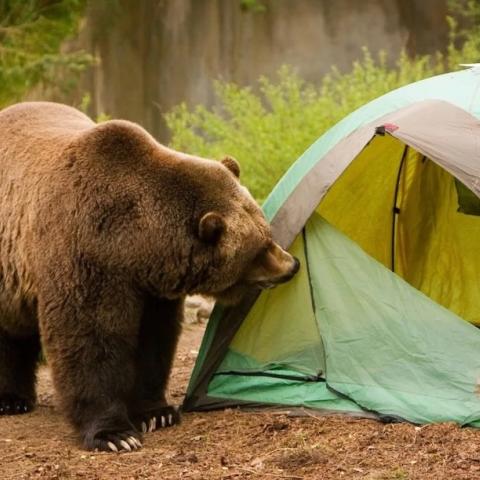
Grand Teton National Park's "State of the Park" report is out/Kurt Repanshek file
A 35-page document from Grand Teton National Park that might have sailed under the radar for most visitors to that rugged national park that helps hold up Wyoming's western border provides a good behind-the-scenes look at managing the park and protecting its resources for more than 3 million annual visitors.
"We need to be reporting out to our stakeholders and the American public about how we spend their funding in order to be able to manage the park," Grand Teton Superintendent Chip Jenkins explained while discussing Grand Glimpse: 2024 State of the Park during the National Parks Traveler's weekly podcast.
The document, he said, is intended to "convey the complexity of what it means to manage a park like Grand Teton."
"And by no means are we unique," the superintendent added. "There are many, many units across the [National Park] system that are similarly complex. And there are many units across the Park Service that are being faced with the opportunity and the challenges of having millions of people come and visit when you've got infrastructure that is 75 years old, and you've got growing shoulder seasons and limited staff capacity, limited facility capacity."
The document, available in PDF form at this page on the park's website, provides overviews of the Park Service's work pertaining to the health of natural resources, such as the Snake River and grizzly bears, habitat restoration efforts, the preservation and management of historic structures such as those found along Mormon Row, addressing ecosystem threats, finding affordable employee housing, and, of course, working to provide an enjoyable visitor experience.
That latter one might be the most important to visitors, and the numbers indicate the challenges the park staff faces: Grand Teton saw "3,417,106 recreation visits in 2023, a 22 percent increase from 2022." And not all of those visitors were entirely happy with their experience, the Grand Glimpse notes.
"Forty-three percent of respondents stated that they somewhat or strongly agreed that Grand Teton is too crowded," the report states. Also mentioned in a collection of visitor comments was the challenge of "finding lodging that is not too expensive."

Jenkins found the comments about a lack of solitude "not surprising."
"It depends on where folks are, right, and it depends on what folks' expectations are," he said. "If you are looking for a day of solitude and you find yourself at Jenny Lake between eight in the morning and six in the afternoon, you're probably not going to feel a sense of solitude. However, if you're there after six o'clock at night, solitude is relatively easy to find. And, you know, it's an interesting thing about Grand Teton: we are largely now a day use park, where people spend a night within a two- or three-hour drive of Grand Teton, they come in in the morning between eight and 10, they leave sometime between two and four. And if you come in before that time, or after that time, you actually can find solitude in most of the places in the park."
Lodging in the park is expensive, both because the Grand Teton is a highly desireable park to visit and because the concessionaire that operates Jackson Lake Lodge, Jenny Lake Lodge, and the Colter Bay cabins — the Grand Teton Lodge Company — is allowed to let market demand drive some nightly rates in those places. Nightly rates at Jackson Lake Lodge quickly reach $500 in mid-summer, while those at Jenny Lake Lodge, where the nightly fee includes "a nightly five-course dinner, gourmet breakfast, daily horseback riding, and use of our cruiser-style bicycles," surpass $1,000.
"There is no doubt that overnight accommodations in this part of the world, whether you're in lodging in the park or lodging in the local community, it's really expensive," acknowledged Jenkins. "Just hearing from the [Jackson Hole] tourism bureau, it sounds like hotel rooms are kind of reaching an all-time high and the market seems to be bearing that. It's expensive for people to visit."
When they do visit, many travelers come to seek out the park's wildlife. Bears — black and grizzly —, wolves, elk, bison, and moose are some of the frequently sighted residents. And perhaps the most sought-out resident is bear No. 399, a grizzly sow that has roamed the Tetons for nearly three decades. In May 2023 she was spotted with a new cub, making her the "oldest documented grizzly bear in the Greater Yellowstone Ecosystem (GYE) to have successfully reproduced at the age of 27."
“She’s an ambassador for her species,” Grand Teton bear biologist Justin Schwabedissen notes in the Grand Glimpse.
Jenkins said the sow has been spotted this spring.
"399 is around. She's got a two-year-old cub with her this year," he said. "She was seen earlier in May, somewhat regularly, but she has not been seen recently. And what our bear biologists tell us is that this is kind of consistent for her behavior in the past. She's very, very adept at being able to be kept off the radar screen when she wants to be stealthy, and it appears she's in a period of time where that's exactly what she's doing."
To read the entire Grand Glimpse document, head over to this page. Or, download National Parks Traveler Episode 280 | State of Grand Teton and listen to the entire conversation.




 Support Essential Coverage of Essential Places
Support Essential Coverage of Essential Places






